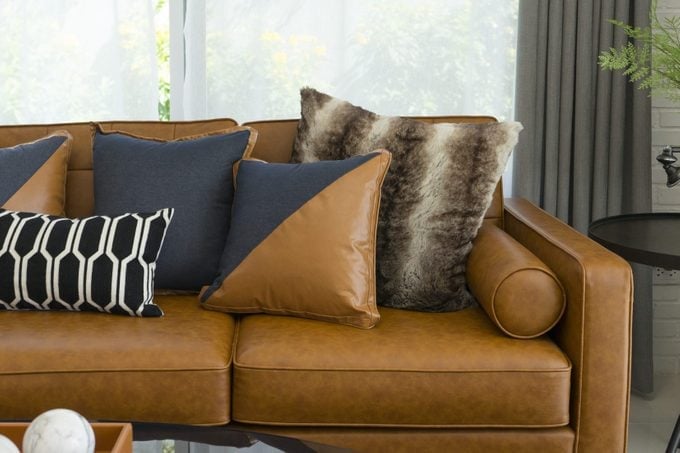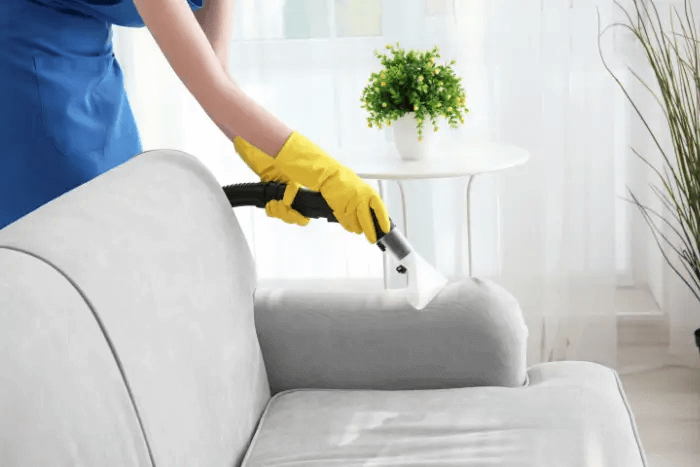A couch is a favorite spot for relaxation, movie nights, and cuddling with pets. But over time, it collects dirt, stains, and odors, making it look worn out. Wondering how to clean a couch? Everyday use, spills, and crumbs can leave it looking dull, but the right cleaning methods can bring it back to life. This guide covers effective techniques to remove grime and keep your couch fresh and inviting.
So, let’s begin
Understanding Your Couch’s Material
Before diving into cleaning solutions, it’s crucial to identify your couch’s upholstery. Different fabrics require specific approaches to avoid permanent damage. Each material requires a different cleaning approach to avoid damage.
Here’s a breakdown of some common couch materials:
- Fabric Couch: This broad category encompasses various textiles like cotton, linen, and polyester blends.
- Leather Couch: Luxurious and durable, leather needs special care to maintain its suppleness.
- Cloth Couch: An umbrella term often used interchangeably with fabric couches.
- Microfiber Couch: Known for its soft, stain-resistant properties, microfiber requires gentle cleaning.
- Suede Couch: This delicate material requires special cleaning techniques to avoid roughening the nap.
- White Couch: While undeniably chic, white couches demand more frequent cleaning due to their visibility.
- Velvet Couch: This luxurious fabric adds a touch of elegance, but its delicate nature requires specific cleaning methods.
- Polyester Couch: A popular choice for its durability and affordability, polyester couches are generally easy to clean.
Pro Tip: Check the manufacturer’s label or tag on your couch for cleaning instructions specific to its material.
How to Clean a Couch Fabric?

The upholstered furniture industry uses specific codes to indicate the recommended cleaning methods for different materials:
- W: This code indicates that water-based cleaners are safe to use, making cleaning relatively easy.
- W/S: This code means that both water- and solvent-based cleaners are safe to use on the fabric.
- S: This code indicates that only solvent-based cleaning chemicals should be used for cleaning.
- X: This code means that the fabric should only be vacuumed or brushed, and no further cleaning methods should be used.
Preparing Your Couch for Cleaning

Before you start cleaning, remove any cushions or removable covers from your couch. Vacuum the sofa thoroughly to remove loose dirt, dust, and debris. Use a soft brush attachment to prevent damage to the fabric. For leather couches, use a soft, damp cloth to wipe down the surface and remove any surface dirt.
Here are the things you’ll need to clean your couch:
- Vacuum Cleaner
- Microfiber Cloths
- Soft Bristle Brush
- Baking Soda
- White Vinegar
- Dish Soap
- Spray Bottle
- Steam Cleaner
NOTE:
Always test any cleaning solution on an inconspicuous area of your couch before applying it to the entire surface. This helps identify any potential discoloration or damage.
Now, let’s learn how to clean a couch in the right way:
How to Clean a Fabric Couch
- Fabric couches are cozy and comfortable but can be prone to stains.
- To clean a fabric couch, start by checking the cleaning code on the manufacturer’s label.
- W, S, SW, or X indicate the recommended cleaning method.
- Vacuum regularly, using the upholstery attachment to remove dust and debris.
- For most fabric couches, you can spot clean stains with a mixture of mild detergent and water.
- Another way is to mix a solution of warm water, dish soap, and vinegar in a spray bottle.
- Lightly mist the couch, scrub gently with a microfiber cloth, and then blot with a clean, damp cloth to remove residue.
- For deeper cleaning, consider using a steam cleaner to lift stubborn dirt and stains.
- Allow the couch to air dry completely.
How to Clean a Leather Couch

- Leather couches are luxurious and durable, but require special care to maintain their appearance.
- To clean a leather couch, start by dusting the surface with a soft, damp cloth to remove any surface dirt.
- Next, mix a mild soap with water to create a cleaning solution.
- Gently wipe the leather with the solution using a clean cloth, then buff the leather with a dry cloth to restore its shine.
Pro Tip: Every few months, use a leather conditioner specifically formulated for your type of leather. Avoid harsh chemicals and excessive moisture.
How to Clean a Microfiber Couch

- Microfiber couches are soft and durable, but can be challenging to clean.
- To clean a microfiber couch, start by vacuuming the surface to remove loose dirt and debris. (Use a vacuum cleaner with the upholstery attachment.)
- Next, spray a small amount of rubbing alcohol on a clean cloth and clean the stains.
- You can also try a microfiber cleaning solution or a mild dish soap and water solution.
- Avoid using harsh chemicals and scrubbing, as this can damage the fabric.
- Allow the couch to air dry, then brush the fabric with a soft brush to restore its texture.
Pro Tip: To keep your microfiber couch clean, address spills immediately by blotting with a clean, absorbent cloth.
How to Clean a Suede Couch

- Suede couches are stylish but require gentle cleaning to avoid damaging the fabric. To clean a suede couch, start by brushing the fabric with a suede brush to remove surface dirt and restore the nap.
- Next, use a suede eraser to gently rub away stains.
- For oil-based stains, sprinkle cornstarch or talcum powder on the stain and let it sit for a few hours before brushing it away.
- Avoid using water or harsh chemicals on suede.
- Call professionals for stubborn stains.
How to Clean a White Couch

- White couches require more frequent cleaning due to their visibility.
- Follow the cleaning instructions for your specific fabric type (W, W/S, S, X) to determine the appropriate cleaner.
- However, be extra cautious when using cleaning solutions.
- Blot up spills immediately to prevent staining.
- For water-based stains, use a mild detergent and water solution.
- For oil-based stains, sprinkle baking soda or cornstarch, then vacuum.
- Regular maintenance with vacuuming and prompt stain treatment is key.
How To Clean a Velvet Couch

- Velvet couches add a touch of luxury to any living space, but they require gentle care to maintain their plush appearance.
- To clean a velvet couch, start by vacuuming the surface with a soft brush attachment to remove dirt, debris, and pet hair.
- Next, mix a small amount of dish soap with water to create a cleaning solution.
- Test the solution on an inconspicuous area of the couch before applying it to the entire surface.
- Avoid scrubbing or using harsh chemicals or abrasive cleaners, which can damage the delicate velvet fibers.
- Brush the fabric with a velvet brush or soft cloth to restore its texture.
- Allow your velvet couch to air dry completely.
How To Clean a Polyester Couch

- Compared to other couch fabrics, polyester is a relatively easy-care fabric.
- To clean a polyester couch, start by vacuuming the surface and addressing spills promptly.
- For routine cleaning, mix a solution of warm water and dish soap in a spray bottle.
- Lightly mist the couch, scrub gently with a microfiber cloth, and then blot with a clean, damp cloth to remove residue.
- Make sure to keep your couch air-dry completely before using it again.
Pro Tip: Regular cleaning and maintenance will help keep your polyester couch looking its best for years to come.
How to Deep Clean Your Couch
Is your couch too dirty, and do you want to deep clean it?
Here is how to do it the easy way:
- Deep cleaning your couch is essential to removing deep-seated dirt and odors.
- To deep clean your sofa, start by vacuuming the surface to remove loose dirt and debris.
- Next, apply a cleaning solution suitable for your couch’s material and let it sit for a few minutes to loosen dirt.
- Use a soft brush or cloth to gently scrub the couch, then rinse with clean water and let it air dry for a couple of hours.
How to Clean Couch Cushions

Couch cushions can become dirty and stained over time. To clean couch cushions, start by removing the covers and checking the care label for cleaning instructions. Most cushion covers can be machine-washed in cold water with a mild detergent. For non-removable cushions, spot clean stains with a mixture of mild detergent and water, then let them air dry thoroughly before replacing the covers.
How to Maintain Your Couch
Now that your couch is sparkling clean, here are some tips to maintain its pristine state:
- Clean up spills as soon as they happen to prevent them from setting in.
- Vacuum your couch at least once a week to remove dust, crumbs, and pet hair.
- Regularly rotate and fluff all the cushions to promote even wear and tear. Wash removable cushion covers according to the care label instructions.
- Consider a shoes-off policy in your living area to minimize dirt tracked onto the couch.
- For fabric couches, consider using a fabric protector spray to prevent stains.
- For leather couches, use a leather conditioner to keep the leather supple and prevent cracking.
- Invest in throws or covers for areas where pets spend a lot of time to minimize pet hair and potential stains.
Summary
| Couch Cleaning Guide | |
| Material | Cleaning Method |
| Fabric (W/S/X) | Vacuum and spot clean with mild detergent/water or vinegar solution. Deep clean with steam cleaner (check label). |
| Leather | Dust, wipe with mild soap & water solution, and buff dry. |
| Microfiber | Vacuum, blot stains with rubbing alcohol or cleaning solution. Avoid harsh chemicals & scrubbing. |
| Suede | Brush with suede brush, use suede eraser for stains.Avoid water & harsh chemicals. |
| White (W/S/X) | Clean spills immediately. Use water solution for water-based stains, baking soda/cornstarch for oil-based stains. |
| Velvet | Vacuum with soft brush attachment. Use a mild dish soap solution (test first). No scrubbing or harsh chemicals. |
| Polyester | Vacuum, address spills promptly. For cleaning, use warm water & dish soap solution. |
FAQs
It’s recommended to clean your couch at least once every 6-12 months, depending on use and household factors.
To freshen up a smelly couch, sprinkle baking soda over the surface, let it sit for 15-20 minutes, then vacuum it up.
Use a steam cleaner with an upholstery attachment, following the manufacturer’s instructions and using a suitable cleaning solution.
Blot up as much urine as possible with paper towels, then clean the area with a mixture of water and vinegar. Follow up with a pet odor neutralizer.
Mix a small amount of mild detergent with water, apply it to a clean cloth, and gently wash the stains. Use a separate cloth soaked in clean water to rinse, then dry with a towel.
Conclusion
A clean couch not only looks better but also creates a healthier and more inviting living space. By following these cleaning techniques and preventative measures, you can ensure your couch remains a comfortable and stylish spot to hangout for years to come. Whether you have a fabric, leather, microfiber, suede, or polyester couch, regular cleaning and maintenance are crucial to preserving its beauty and comfort. So, after complete cleaning, relax, and enjoy your clean and inviting couch!
Explore Further

